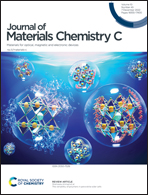Hierarchical pompon-like cobalt phosphide as a platinum-free electrocatalyst for dye-sensitized solar cells†
Abstract
Different cobalt phosphide particles having one-dimensional needle-like (1D CoP-N), two-dimensional sheet-like (2D CoP-S), and multi-dimensional pompon-like (3–2–1D CoP-P) morphologies were successfully synthesized via a simple hydrothermal method, followed by phosphorization post-treatment. A soft-template of a pompon-like Co(OH)X-P particle was first grown via a three-step mechanism: (1) the formation of a 2D micro-sheet, (2) the construction of a 3D micro-flower due to the radial growth of a 2D nano-sheet/silk on the micro-sheet, and (3) the perpendicular decoration of numerous 1D nano-needles on every 2D micro-sheet. After the phosphorization process, a hierarchical charge transfer route from a 3D micro-flower to a 2D micro-sheet and lastly to a 1D nano-needle array was effectively established in a pompon-like CoP micro-sphere in the presence of numerous electrochemical active sites. In order to serve as the electrocatalyst for triiodide ion (I3−) reduction in dye-sensitized solar cells (DSSCs), the electrodes having 1D CoP-N and 3–2–1D CoP-P rendered their devices with satisfactory cell efficiencies (η) of 8.50% and 8.80%, respectively, which were better than the expensive Pt-based cell (8.24%). Under a room light illumination, the pompon-like CoP electrocatalyst rendered its device satisfactory performance up to 17.27% at 7 klux (for lampshade) and 14.22% at 1 klux (for office), implying the promising potential of CoP-based materials to replace Pt in DSSCs and other electrochemical devices.



 Please wait while we load your content...
Please wait while we load your content...